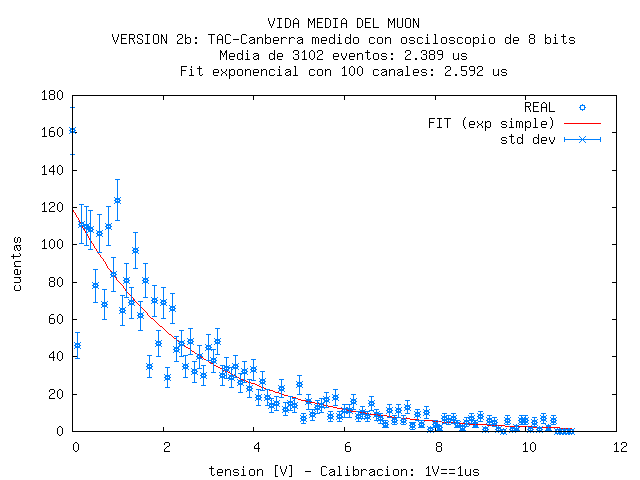The muon lifetime experiment
PART V: Four different versions of the experiment
SECOND EXPERIMENT - Runs 8 and 9
TAC output recorded with scope
Only BIG scintilator, with anode to discriminator as previous experiment. All muons generate a START, not only the coincidences. But also eventuals do. They must be kept at minimum with discriminator level (4.5 ~10 Hz) and high voltage (2000 V) combination.
NIM output of discriminator connected to TAC STOP and, through a small delay (5 ns), also to START.
TAC range set to 10 μs, output to scope CH1, measuring amplitude in MEAS1, to PC. If second pulse (electron) does not arrive before 10 μs, TAC resets and no output is present. Else generates output proportional to time between consecutive anode pulses, i.e. muon lifetime. Scope records TAC output amplitude and reports to PC that records in ascii file. Pulse amplitude scope resoution approx 8-9 bits. Resulting histogram has a maximum of 256 channels.
TAC calibrated with Ortec 462 Time Calibrator.
Layout
Run 9
TAC range set to 10 μs. Discriminator level = 4.5, output rate (START) ~10 Hz. Reduced probability of eventual stops (see calculations).
3100 stoped and detected muons y ~3 days. Muon stop rate ~1 every 100 seconds. Measured τμ = 2.59 μs
Histogram of true stops and mean:

Notes
A disadvantage of this method is that absolute time information of the events is not recorded, so rate calculations are not possible.
Limitation of the scope to record small pulses (lots of 0s). The best will be to use a MCA. See next experiment.
Mean value approximates lifetime very well because there is a very small probability of eventual STOP (almost no background).
Run 8 was with TAC Ortec 457 (Toto). Several reasons why not reported: 1) No true stop available, so it was improvised with negative output of the TAC through a low discriminator (436). This signal was used to trigger the scope. 2) Through this run several changes to the MEAS1 of the scope: histogram (best for pulses), no BW limit, time base 400 ns/div to calculate better, and measure 'High' not 'Amplitude'. 3) TAC was found to be unstable. See calibration with 462. TAC changed to Canberra 2143 for run 9 and all three problems were solved.
